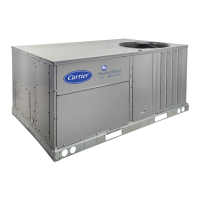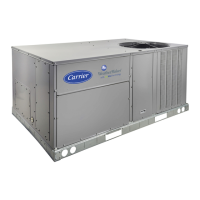26
operating circumstances. The ComfortLink controller overrides
the third party signal for critical operation situations, most no-
tably smoke and fire control. Wire the input to the controls ex-
pansion module (CEM) using TB-11 and 12. An optional CEM
board is required.
See Appendix C and the VFD literature supplied with the unit
for VFD configurations and field wiring connections to the
VFD.
Supply Air Reset
With the installation of the CEM, the ComfortLink controller is
capable of accepting a 4 to 20 mA signal, to reset the supply-
air temperature up to a maximum of 20°F. See VFD Control
section above.
Demand Limit Control
The term “demand limit control” refers to the restriction of the
machine’s mechanical cooling capacity to control the amount
of power that a machine may use.
Demand limiting using mechanical control is possible via two
means:
1. Two discrete inputs tied to demand limit setpoint percentages.
2. A 4 to 20 mA input that can reduce or limit capacity linearly
to a setpoint percentage.
In either case, it will be necessary to install a controls expan-
sion module (CEM).
DEMAND LIMIT DISCRETE INPUTS
First, set DM.L.S in Configuration
DMD.L to 1 (2 switches).
When Inputs
GEN.I
DL.S1 (Demand Switch no. 1) is
OFF, the control will not set any limit to the capacity, and when
ON, the control sets a capacity limit to the Configuration
DMD.L
D.L.S1 setpoint.
Likewise, when Inputs
GEN.I
DL.S2 (Demand Switch
no. 2) is OFF, the control will not set any limit to the capacity,
and when ON, the control sets a capacity limit to the Configu-
ration
DMD.L
D.L.S2 setpoint.
If both switches are ON, Inputs
GEN.I
DL.S2 is used as
the limiter of capacity.
Under Configuration
SW.LG, set the logic state appropri-
ately for the action desired. Set the DL1.L and DL2.L configu-
rations. They can be set normally open or normally closed. For
example, if DL1.L is set to OPEN, the user will need to close
the switch to cause the control to limit capacity to the demand
limit 1 setpoint. Likewise, if DL1.L is set to CLSE (closed), the
user will need to open the switch to cause the control to limit
capacity to the demand limit 1 setpoint.
DEMAND LIMIT 4 TO 20 MA INPUT
Under Configuration
DMD.L, set configuration DM.L.S to 2
(2 = 4 to 20 mA control). Under the same menu, set D.L.20 to a
value from 0 to 100% to set the demand limit range. For exam-
ple, with D.L.20 set to 50, a 4 mA signal will result in no limit to
the capacity and 20 mA signal will result in a 50% reduction in
capacity.
Demand Controlled Ventilation Control
There are multiple methods for externally controlling the econ-
omizer damper.
IAQ DISCRETE INPUT CONFIGURATION
The IAQ discrete input configuration requires a CEM module
(optional) to be installed and an interface to a switch input at
TB5-13 and 14. The state of the input on the display can be
found at Inputs
AIR.Q
IAQ.I.
Before configuring the switch functionality, first determine
how the switch will be read. A closed switch can indicate ei-
ther a low IAQ condition or a high IAQ condition. This is set at
Configuration
SW.LG and IAQ.L. The user can set what a
low reading would mean based on the type of switch being
used. Setting IAQ.L to OPEN means that when the switch is
open the input will read LOW. When the switch is closed, the
input will read HIGH. Setting IAQ.L to CLSE (closed) means
that when the switch is closed the input will read LOW, and
therefore, when the switch is open the switch will read HIGH.
There are two possible configurations for the IAQ discrete in-
put. Select item Configuration
IAQ
AQ.CF
IQ.I.C
and configure for either 1 (IAQ Discrete) or 2 (IAQ Discrete
Override).
IQ.I.C = 1 (IAQ Discrete)
If the user sets IQ.I.C to 1 (IAQ Discrete), and the switch logic
(Configuration
SW.LG
IAQ.L) is set to OPEN, then an
open switch reads low and a closed switch reads high.
If the switch is open, the economizer will be commanded to the
IAQ Demand Vent Minimum Position.
These settings may be adjusted and are located at Configura-
tion
IAQ
DCV.C
IAQ.M.
If the switch is closed, the IAQ reading will be high and the
economizer will be commanded to the Economizer Minimum
Position.
This setting may be adjusted and is located at Configuration
IAQ
DCV.C
EC.MN.
IQ.I.C = 2 (IAQ Discrete Override)
If the user sets IQ.I.C to 2 (IAQ Discrete Override), and Con-
figuration
SW.LG
IAQ.L is set to OPEN, then an open
switch reads low and a closed switch reads high.
If the switch reads low, no action will be taken. If the switch reads
high, the economizer will immediately be commanded to the IAQ
Economizer Override Position. This can be set from 0 to 100%
and can be found at Configuration
IAQ
AQ.SP
IQ.O.P.
FAN CONTROL FOR THE IAQ DISCRETE INPUT
Under Configuration
IAQ
AQ.CF, the IQ.I.F (IAQ Dis-
crete Input Fan Configuration) must also be set. There are three
configurations for IQ.I.F. Select the configuration which will
be used for fan operation. This configuration allows the user to
decide (if the supply fan is not already running), whether the
IAQ discrete switch will start the fan, and in which state of oc-
cupancy the fan will start.
IAQ ANALOG INPUT CONFIGURATION
This input is an analog input located on the main base board
(MBB). There are 4 different functions for this input. The loca-
tion of this configuration is at Configuration
IAQ
AQ.CF
IQ.A.C.
The functions possible for IQ.A.C are:
• 0 = no IAQ analog input
• 1 = IAQ analog input
• 2 = IAQ analog input used to override to a set position
• 3 = 4 to 20 mA 0 to 100% economizer minimum position
control
• 4 = 0 to 10,000 ohms 0 to 100% economizer minimum po-
sition control
Options 2, 3, and 4 are dedicated for third party control.
IQ.A.C = 2 (IAQ Analog Input Used to Override)
Under Configuration
IAQ
AQ.SP, set IQ.O.P (IAQ
Economizer Override Position). The IQ.O.P configuration is
IQ.I.F = 0 Minimum Position Override Switch input will
not start fan
IQ.I.F = 1 Minimum Position Override Switch input will
start fan in occupied mode only
IQ.I.F = 2 Minimum Position Override Switch input will
start fan in both occupied and unoccupied
modes

